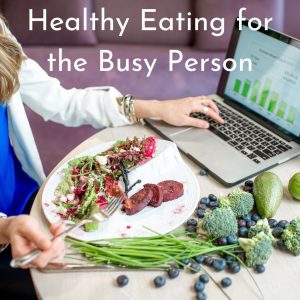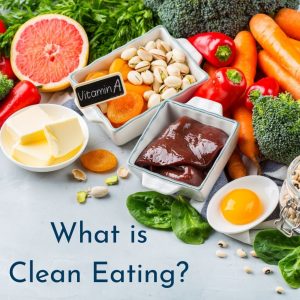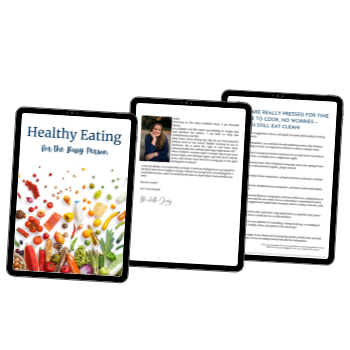Welcome to the Simple Steps to Improved Health Challenge Day 15 Eat Fruits and Veggies First
Reminder to choose 1 of the first two actions to work on this week starting today or whatever day you want the week to start on for you. See Day 1 for more information about the challenge.
How Does Eating Fruits and Veggies First Improve Health
Eating fruits and veggies have many health benefits. One important benefit that helps with weight loss includes fiber. Fiber fills you up and boosts gut health. Fiber also helps your stomach to slow down digestion which can help with blood sugar spikes.
Fruits and veggies help protect you against some diseases because of the phytochemicals they may contain. They are also a good source of vitamins and minerals that your body needs to complete processes such as detoxification and autophagy.
Fresh fruits and veggies are also quick and easy foods. They don’t require packaging and you can grab and go to take them with you anywhere. There is a large variety of fruits and vegetables that you can add to your life and they are fun to eat with an array of colors and textures.
There are studies that indicate a protective effect when you eat fruits and vegetables from cancers, cardiovascular disease, high blood pressure, gut health, and vision. Additionally, there is a potentially lower risk of type 2 diabetes and weight gain.
How to Take Action to Eat Fruits and Veggies
You can find the USDA’s recommended daily servings of fruits and vegetables on MyPlate.
Recommended Servings of Fruits and Vegetables
The important thing is to get in the recommended servings of fruits and vegetables. It is recommended that you get 4-5 servings in a day. 1.5 to 2 cups of fruit and 2 to 3 cups of vegetables. That may seem like a lot but understanding what a serving size is will help.
A serving is about one medium fruit or 1/2 a cup of fresh, frozen, or canned pieces. For vegetables about 1 cup if it is a leafy green or 1/2 cup for fresh, frozen, or canned.
Make it Convenient
Consider having one whole fruit a day. Grab a banana, apple, or orange to have with lunch or as a snack. Bring a bag of grapes to work and have a 1/2 cup with lunch. Bring some raw baby carrots or broccoli to your child’s sporting event. How about a cucumber for a snack when you get home for the day.
Add Color to Your Salad or Dinner
Plan to have 2 servings of vegetables with dinner. Think about color. Different colors have different vitamins and minerals.
Get some reds or purples with beets, radishes, or berries. Have some oranges with carrots, oranges, and peppers.
How about some yellows with squash or mangos. There are many different greens with a variety of colors.
Common Reasons it is Hard to Get Fruits and Veggies
What if you are in a food desert?
Try buying frozen fruits and veggies which have the same nutritional make-up but can be stored longer.
Consider going in with someone else to a large grocery store outside your neighborhood and stock up on fresh for the immediate week and frozen fruits and veggies for the weeks between trips.
This also works if cost is a problem because often frozen and canned items cost less and have a longer shelf life. Another thing that works for both is to purchase fruits and vegetables that are in season. In season they will have the lowest cost and be the freshest.
What if you have trouble getting to a store?
You can’t drive or you have a condition that makes it difficult for you to shop. Use grocery delivery. Additionally, you could have a friend or family member shop for you.
What if you don’t like the taste of many fruits and vegetables?
You can improve the taste by adding a dip or sauce. You might also what to try out different cooking styles or spices to use. Adding fruits and vegetables to a favorite dish can give you that nutrient boost with little change in flavor to the dish.
For a big increase in your fruit and vegetable servings, you can make a smoothie with multiple servings and variety.
Why Eat Fruits and Veggies First?
The main reason to eat fruits and vegetables first is because of the nutrition they contain. All those vitamins, minerals, and phytochemical compounds help your body to be healthier.
The second reason is that you will get full with the fiber from the fruits and vegetables and won’t overeat as much of the other foods that may have more empty calories.
Go Do it
1. Log how many fruits and vegetables you are getting in a day or week. It can be as simple as a checkmark for each serving you have.
2. Decide how many fruits and vegetables you would like for the day.
If you are getting nowhere near the recommendations then decide to add one more serving a day or one more serving of both a day. If you are close to recommendations then decide to focus on adding the one you are getting least of whether that is a fruit or a vegetable.
3. Plan to have that extra one or two servings in the day. Chose a convenient or a favorite fruit or vegetable as a backup plan in case you don’t get in the one you planned during the day and have it with dinner.
4. Purchase your planned fruit or vegetables for the week and backup fruit or vegetables.
5. Post on your refrigerator or use a reminder on your phone to tell yourself to eat your planned fruit or vegetable.
6. Eat your Fruits and Veggies First. That doesn’t mean the entire serving but get a good couple bites in before you tackle the rest of your meal so the fiber can do its job.









